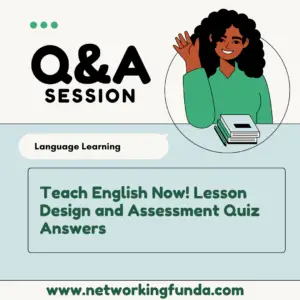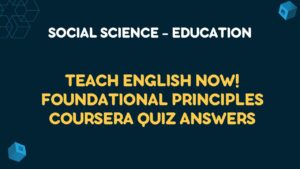All Weeks Copyright Law Coursera Quiz Answers
Table of Contents
Copyright Law Week 01 Quiz Answers
Quiz 1: What Copyright is Not
Q1. Mark, a young biochemist, creates a new pharmaceutical drug. This drug has the potential capability to eradicate the Zika virus. Is Mark able to obtain a copyright for his invention?
- Yes
- No
Q2. While sitting at a restaurant Tina, draws an impressive replication of the Grand Canyon on her napkin. Must Tina file for a copyright in order for her drawing to receive copyright protection?
- Yes
- No
Quiz 2: Quiz on Expression
Q1. Jake writes and publishes a non-fiction book
detailing the accounts of the survivors of the Titanic. What aspects, if any,
of Jake’s work are protected by copyright law?
- The non-fiction accounts of the survivors
- The organization, structure, and presentation of
the accounts - Both the non-fiction accounts of the survivors
and the organization, structure, and presentation of the accounts - Neither the non-fiction accounts of the
survivors or the organization, structure, and presentation of the accounts
Q2. True or False. Asserting free speech rights is
always a defense to a claim of copyright infringement.
- True
- False
Quiz 3: Expression vs. Ideas
Q1. In the case of Bikram’s Yoga v. Evolation Studios why was the plaintiff unable to successfully make out a claim of copyright infringement?
- Because the plaintiff was trying to copyright too many yoga poses.
- Because the plaintiff was trying to copyright a sequence, which is akin to seeking copyright protection for an idea.
- Because the poses were public knowledge
Q2. True or False: You have devised a new method for multiplying three digit numbers. You can obtain copyright protection for your new method.
- True
- False
Quiz 4: Copyright Law
Q1. True or False. As long as the work originates in the author, it does not matter if there are other similar things in the world that are identical to it.
- True
- False
Q2. True or false. The threshold for originality is very high.
- True
- False
Q3. True or False. For copyright protection to attach, the work must have an author.
- True
- False
Q4. Which of the following is an expression of an idea that can be copyrighted?
- The Dewey Decimal System
- E=MC^2
- Bikram’s Yoga Poses
- The written memoirs of an adventurous sailor.
Q5. Which of the following can you copyright?
- The newspaper headline “Queen of England dies.”
- A pawprint in the snow made by your dog
- An original novel you wrote, which one critic called “unoriginal, uninspired, and just another boy-meets-girl story.”
- Your first-edition copy of the book “The Catcher in the Rye.”
Copyright Law Week 02 Quiz Answers
Quiz 1: Reproduction Right
Q1. True or False. You can violate the reproduction right through non-literal copying.
- True
- False
Quiz 2: Distribution Right
Q1. True or False. An individual can bring a claim for a violation of both the reproduction right and the distribution right against two different people.
- True
- False
Quiz 3: Copyright Law
Q1. True or False: When a copyright owner holds an exclusive right, that means that the holder of the copyright is the only person who can exercise, or authorize someone else to exercise, that right.
- True
- False
Q2. True or False: The six main exclusive rights of copyright all attach to all categories of creative works.
- True
- False
Q3. True or False. Uploading content to a publically available website for others to use and download constitutes an act of public distribution, which amounts to an infringement based on the public distribution right.
- True
- False
Q4. The first sale doctrine is an exception to which exclusive right?
- The Public Display Right
- The Public Performance Right
- The Reproduction Right
- The Public Distribution Right
Q5. If an individual is able to rely on the first sale doctrine as a defense to violating the public distribution right, the individual has not committed any kind of copyright infringement. Choose the best answer.
- True
- False
Copyright Law Week 03 Quiz Answers
Quiz 1: The Adaptation Right
Q1. Which of the following is an example of a derivative work?
- Lucy wrote a book about a young nun in Austria who must serve as the governess to seven young children during the late 1930’s. John is certain that this book has the potential to become a major commercial success and decides to create a Broadway musical based on Lucy’s story.
- Lucy wrote a book about a young nun in Austria who must serve as the governess to seven young children during the late 1930’s. Jeremy thoroughly enjoys this book and decides to write his own book copying verbatim nearly all of the content Lucy incorporated into her novel.
- Lucy wrote a book about a young nun in Austria who must serve as the governess to seven young children during the late 1930’s. Jeremy enjoys this book and decides to photocopy Lucy’s book and sell this book on the streets of Salzburg.
Quiz 2: Authorship
Q1. True or False. You can contract away authorship, but you cannot contract away ownership.
- True
- False
Quiz 3: Copyright Law
Q1. What is the primary purpose of the adaptation right? Select the best answer.
- To require creators to obtain permission from the original copyright owner so that copyright owners are aware of potential derivative works.
- To encourage creators to work collaboratively with copyright owners to avoid future litigation.
- To allow copyright owners to control the downstream markets for modifications of their works.
Q2. True or False. The Public Display Right applies to all categories of works.
- True
- False
Q3. True or False. The Right of Attribution permits the author to prevent the use of his or her name as the author of any work, which he or she did not create.
- True
- False
Q4. True or False: The author of a book called “Angels of Space” gives you the right to copy and sell the book (reproduction right). This also gives you the right to create a movie version of “Angels of Space.”
- True
- False
Q5. Which of the following does the Public Performance Right NOT apply to?
- Books
- Movies
- Music
- Sculptures
Copyright Law Week 04 Quiz Answers
Quiz 1: Fair Use Basics
Q1. True or False. The fair use doctrine has its roots of origin in the copyright statute.
- True
- False
Quiz 2: Ordinary Fair Use
Q1. Choose the Best Answer. How many factors comprise fair use?
- Two
- Three
- Four
- Five
Get All Course Quiz Answers of Intellectual Property Law Specialization
Introduction to Intellectual Property Coursera Quiz Answers
Copyright Law Coursera Quiz Answers
Trademark Law Coursera Quiz Answers
Patent Law Coursera Quiz Answers



